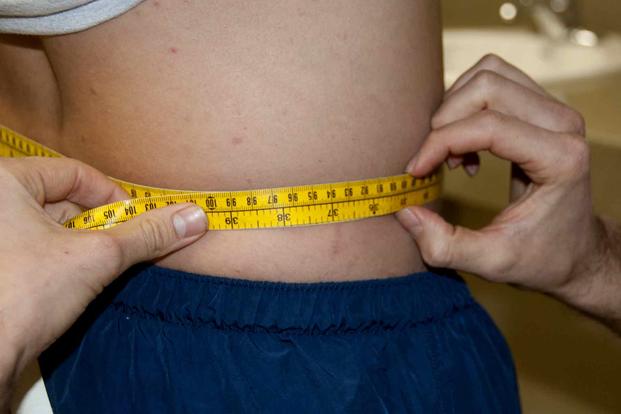Airmen and Guardians will no longer have to go through the dreaded abdominal tape test, but will have their waist and height measured to keep tabs on their physical health and physique under a new assessment, according to the Department of the Air Force.
The Air Force and Space Force's new Body Composition Program, first reported by Military.com, will be implemented in April and use the waist-to-height ratio as a replacement for the old waist measurement portion of the physical assessment.
"The goal of the new program is to empower Airmen to take charge of their health and fitness through lifestyle enhancement to optimize readiness," Lt. Gen. Caroline Miller, deputy chief of staff for Manpower, Personnel and Services, said in a statement. "Regardless of which risk category they fall in, everyone is encouraged to take advantage of the resources available to improve or maintain a healthy body composition."
Read Next: Army Expanding Course for Overweight and Low-Scoring Recruits in Bid to Fill the Ranks
The new program is designed to be less rigid than the former abdominal tape test while still setting a standard for body composition for the force. Unlike the old measurement, the new program is separate from a service member's annual physical fitness test and gives airmen and Guardians more time to meet the Department of the Air Force standards by creating new remediation mechanisms, including counseling.
Officials hope service members will still keep tabs on their abdominal fat, which the Department of the Air Force says "contributes to increased health risks, such as cardiovascular diseases, stroke, diabetes, hypertension and musculoskeletal injuries negatively impacting physical readiness," under the new program.
The Body Composition Assessment, the valuation part of the program, uses a tape measure to compare height to circumference measurements around the hips to determine overall body fat. An equation will use those numbers to create a waist-to-height ratio, or WHtR. A ratio lower than 0.55 is considered healthy and meeting the standard.
"Airmen and Guardians will maintain a WHtR of < 0.55 to meet the BCP standards," the Department of the Air Force said in a release provided to Military.com. Airmen and Guardians will both complete their assessments annually around their birth month, according to the Department of the Air Force.
Those who have a waist-to-height ratio higher than 0.55 "will receive education or a referral based on their risk category and other health concerns if indicated," according to the release.
Airmen and Guardians who don't meet the standard will be enrolled into a "Body Composition Improvement Program" for 12 months and referred to their on-base medical treatment facility for an exam to determine whether they're at risk for any health issues.
While the initial results may not lead to punishment, "failing to test on time, not scheduling or missing an appointment" may be met with "commander-driven administrative actions," the Department of the Air Force said.
Airmen and Guardians who have high-risk results from the Body Composition Assessment and do not improve after their 12-month improvement program will be enrolled in a formal program that "may result in consideration for administrative action, including separation, for continued failures," the Department of the Air Force detailed.
Stew Smith, a former Navy SEAL and fitness author certified as a strength and conditioning specialist who writes a column for Military.com, said in an interview last year that the simplicity of the new equation could help airmen focus on other areas of physical fitness.
"The older height weight measurements were outdated," Smith said. "This is a better math equation than what they had previously, and it seems like this one may be more lenient."
The Air Force's new program was set in motion by Department of Defense Instruction 1308.03, issued last year, which directed the services to create their own body composition programs.
It also comes as all the services reevaluate their physical fitness standards as it becomes harder to recruit young Americans into the ranks.
A Pentagon study, first reported by Military.com last year, shows that 77% of young Americans would not qualify for military service without a waiver due to being overweight, using drugs, or having mental and physical health problems.
Editor's Note: After publication, an Air Force official contacted Military.com to say that the initial information released by the service contained an error in terms of timing for Space Force Guardian fitness assessments. They will be assessed in their birth month, consistent with the policy for airmen. This article has been updated accordingly.
-- Thomas Novelly can be reached at thomas.novelly@military.com. Follow him on Twitter @TomNovelly.
Related: Air Force Weighs Waist-Height Measurement to Replace Tape Test












